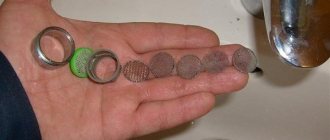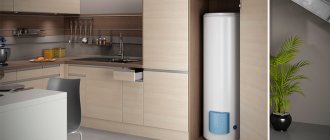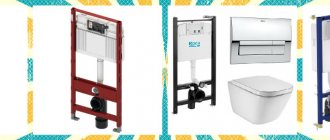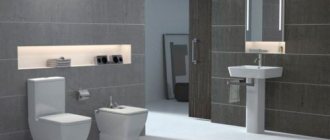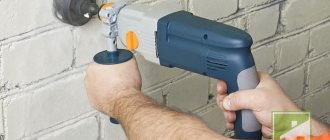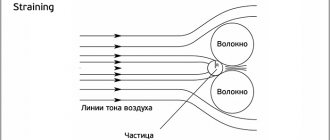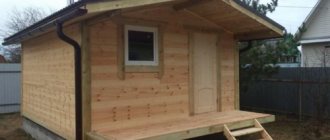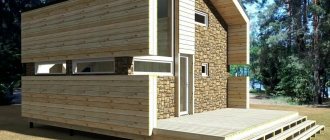Here you will learn:
- Features of instantaneous water heaters
- Advantages and disadvantages
- Technical characteristics of instantaneous water heaters
- Instantaneous water heaters for taps
- How to choose an instantaneous water heater
- How to connect an instantaneous water heater
- Popular models of instantaneous water heaters
- Where to buy instantaneous electric water heater
How to organize hot water supply in a house that is not connected to the gas main? How to get hot water at the dacha? How to survive a summer hot water outage? An instantaneous electric water heater will be the simplest and most effective solution to any of the above problems. It will heat the water to a preset temperature, allowing you to wash dishes, take a shower or wash clothes. How to choose a instantaneous water heater and what to look for when purchasing it?
Features of instantaneous water heaters
Instantaneous water heaters have an extremely simple design - powerful heating elements are installed inside them, providing heating of water to a given or certain temperature. The power of heating elements varies widely; the performance of the equipment depends on this indicator. Flow-through heaters operate in the following way: when there is a flow of water, the heating elements are turned on and heated. As soon as the water flow stops, the system turns off.
Flow models differ from storage models in their miniature size - they can be installed in any room, even the smallest . The heaters are mounted on the wall, and pipes with cold water are supplied to them. Hot water is drawn through another tube - then it flows into the taps and shower heads. Depending on the power of the heating elements, the devices can serve one or several water collection points at once.
A water heater with a tap and a shower head is a universal option for quick installation.
Some types of water heaters come with taps and shower heads. These are kits for quick installation - bought, hung, connected using a flexible hose and started using. There are also instantaneous electric water heaters connected through a shower head - this is an excellent solution during the summer shutdown of the centralized hot water supply.
For use in the country house or in the kitchen, you can purchase a small-sized instantaneous water heater for the tap. It connects instead of a standard tap and allows you to get a sufficient amount of hot water. Such devices are in demand among those who need hot water solely for washing dishes or washing (they are not suitable for taking a shower).
What are the features of flow-through heaters?
- Lack of a storage tank for prepared hot water.
- Small sizes.
- Wall-mounted (or tap-mounted).
- Availability of smooth or step temperature control.
- Saving energy when there is no hot water.
Some readers may object - why are flow-through heaters considered economical, since the power of their heating elements is several times higher than the power of heating elements in storage heaters? The answer is simple - storage water heaters are forced to consume electricity to maintain the temperature of the water in the tank. Instantaneous electric water heaters do not consume electricity when there is no water flow . It turns out that with rare use, flow-through models win.
If you need hot water every day and in large quantities, we recommend choosing storage models. If you need water only occasionally (for example, once a week), we recommend purchasing an instantaneous electric water heater.
Electricity costs for a larger boiler
For a family of 3 people, an 80 or 100 liter boiler is suitable. With an energy consumption of 2 kW per hour, an 80-liter boiler will bring the water to the desired temperature in approximately 185 minutes (3 hours). During a heating session, such a boiler will consume 6 kW of energy per day or 180 kW per month, which will range from 327 to 448 rubles per month. What should you consider?
Installation diagram of instantaneous water heater.
Thus, it is easy to calculate the electricity consumption of a storage water heater:
- you need to decide on the volume of hot water that the family consumes daily;
- find out how many kW of energy a boiler of a suitable size consumes during a heating session (multiply 2 kW/h by the heating time in hours);
- multiply the resulting number by the number of days in the month (by 30).
Advantages and disadvantages
Like any other equipment, instantaneous water heaters have certain advantages and disadvantages. First, we will look at their positive features:
Due to their compact size, such devices do not require much space to accommodate them.
- savings on electricity - if you use hot water very rarely, the savings will be noticeable. For example, you consume water only once a day (take an evening shower) - in this case, a flow-through water bottle will be the best choice;
- ease of installation - all electric instantaneous water heaters are small in size, since they do not have tanks. Installation of instantaneous water heaters comes down to fixing them on the wall and connecting them to a cold water supply;
- wide range of any power - consumers can choose from models with power from 3 to 36 kW . There are also models with lower and higher power - the former are not very efficient, and the latter are intended for commercial and industrial use;
- the presence of models for temporary use is an excellent solution for residents of apartment buildings where there are regular interruptions in the supply of hot water to apartments;
- no maintenance required - this is how such devices compare favorably with their gas counterparts;
- the ability to prepare large volumes of water - it can be heated in unlimited quantities. The same storage boilers can quickly exhaust their entire volume, after which cold water will flow from the tap;
- fully automatic operation - you only need to set the heating intensity or set the exact temperature (depending on the type of control used);
- extreme compactness - the running water heater can be installed anywhere, for example, under the sink, in the bathroom or in a separate room. The main thing is to create reliable protection from direct ingress of water and comply with other operating conditions.
Now let's talk about the negative features:
If the power of your water heater is more than 3 kW, then you need to connect a separate line to it from the electrical panel.
- the high power of heating elements requires good electrical wiring - if you bought a powerful electric water heater, take care of the quality of the wiring. In addition, electrical equipment with a power of more than 3 kW must be powered from a separate electrical line going directly to the distribution board (no bends or twists, only solid wire);
- the need for a three-phase electrical network when using models with a power of 9-12 kW and above - a conventional single-phase network is not able to provide the necessary power. It turns out that to install a powerful water heater you need to connect to a three-phase network - these are additional costs for the connection itself, wires and a three-phase meter;
- dependence of the temperature of hot water on some factors - on the temperature of the incoming water, on the supply voltage. Flow-through models with smooth electronic control do not have this drawback;
- large total electricity consumption with intensive consumption of hot water is another disadvantage for those who need hot water in large quantities;
- During prolonged operation, overheating and automatic shutdown are possible - pouring water around the clock will not work.
Nevertheless, instantaneous water heaters are in a certain demand - you just need to understand what the volumes and regularity of consumption will be, and whether it would be more profitable to purchase a storage model.
Low-power instantaneous electric water heaters can only work in summer, since their heating elements are too low-power to heat ice-cold water from the tap to an acceptable temperature in winter. Therefore, the best choice would be to buy a heater with a power of at least 8-12 kW - focus on these numbers (enough for both a shower and washing dishes).
Installation location
Put the lid back in place and place the heater where it will not be exposed to direct splashes of water.
In this case, the device must be positioned strictly horizontally.
If you place it on a shelf or hang it on a wire, it may tilt and become airy during operation. A section of the heating element that finds itself without water because of this will simply overheat and burn out.
Therefore, you will still have to drill two screws into the wall, maintaining the level of the horizon.
Mistake #4
When used as a shower, it is not recommended to install the heater below the level of a person’s head or place it inside the bathtub.
It is allowed to place it above the sink.
We've sorted out the location and wiring, let's move on to the plumbing.
Technical characteristics of instantaneous water heaters
One of the main characteristics of instantaneous electric water heaters is their throughput. More precisely, performance - this parameter depends on the power of the selected equipment. For example, a simple water heater with a power of 3-3.5 kW provides productivity within 1.5-2 l/min . In this case, the water should heat up to 40-45 degrees.
Please note that such a low-power instantaneous water heater will be practically useless in the cold winter, when the temperature of the water in the water supply drops.
How to choose an instantaneous water heater based on performance? If you plan to purchase such a device exclusively for washing dishes, take a closer look at models with a capacity of 1.5-2 l/min (don’t forget to take into account a small power reserve for the winter if you use it in the cold season). Do you need a water heater for a comfortable shower? Pay attention to models with a capacity of 4-5 l/min. Are you planning to connect and simultaneously use two water points? Buy a water heater with a capacity of 9-10 l/min.
Table for calculating the performance of an instantaneous water heater depending on its power and the temperature of the incoming water.
What about our power? As we've already said, it's best to focus on performance rather than power. If we talk about the correspondence between power and productivity, then it is as follows - heating elements with a power of 8 kW prepare water at a speed of 4.4 l/min, with a power of 3.5 kW - 1.9 l/min, with a power of 4.5 kW - 2.9 l/min, power 18 kW – 10 l/min (ratio slightly less than two to one).
You also need to pay attention to such a characteristic as the type of control - it can be electronic or hydraulic. Electronic control allows you to achieve a stable temperature by adjusting the degree of heating and flow rate. Thanks to this, you will not get burned in the shower due to an unexpected change in pressure or supply voltage. The simplest electronic regulators only work at a certain pressure - if the pressure goes out of a certain range, the outlet water temperature will change.
To monitor the temperature, some advanced water heaters are equipped with LCD or LED digital indicators.
With hydraulic control the situation is worse - it does not react in any way to the force of water flow. But here there is step or smooth adjustment. The number of positions depends on the power of the device. As a rule, models with step adjustment and hydraulic control are cheaper than their electronic counterparts.
Another characteristic is the type of power supply. The electrical network for flow machines can be single-phase or three-phase. Models with a power of over 9-12 kW operate exclusively from a three-phase network , less powerful models are powered from a single-phase electrical network. Some models of water heaters, in the power range from 5 to 9-12 kW, can operate from any type of network.
Table for calculating the cable cross-section and its maximum length depending on the power of the device.
Features and built-in modules:
- working pressure – from 0.1 to 10 atm;
- accelerated heating – allows you to reduce the time from the start of the instantaneous water heater to reaching the set temperature;
- safety valve - will prevent equipment breakdown;
- degree of protection from water - some models are splash-proof, and some can withstand direct water;
- eyeliner - can be bottom, top or side;
- installation type – vertical or horizontal;
- self-diagnosis - present in advanced models with electronic control;
- backlight – present in models with LCD displays;
- indication – can be lamp, LED, with LCD display;
- limiting the heating temperature - will prevent you from getting burned in the shower;
- Remote control – the ability to adjust the temperature from another room;
- overheating protection – will prevent equipment breakdown during prolonged intensive work;
- built-in filter – will allow you to clean the prepared water from impurities.
When choosing an electric instantaneous water heater, you need to focus not only on the technical characteristics, but also on the availability of additional options.
Remember that additional options and modules have a significant impact on the final cost of electric instantaneous water heaters.
Storage heater installation
For those who are interested in how to install an electric storage water heater, it is important to know that when installing such equipment, a safety check valve is required. It will ensure the correct operation of the unit and reduce the likelihood of emergency situations.
A safety check valve for a water heater prevents water from flowing out of the heater, and also, if the maximum pressure in the tank is exceeded, it discharges excess liquid into the sewer through a drain outlet
The water inlet pipe of the water heater is marked in blue to avoid errors when connecting. During installation, a safety valve is installed on it in compliance with the tightness requirements (FUM tape, flax tow, etc. are used). To further connect the water heater to the water supply, use a flexible hose or a hose in combination with pipes (steel, polypropylene or metal-plastic structures are selected according to the type of existing pipeline. The so-called safety group (non-return safety valve) should work flawlessly, so if you use an inexpensive installation kit , it is better to purchase this element separately, choosing high quality.
During self-installation, the sequence of installed elements in the direction from the inlet pipe of the water heater will be as follows:
- tee,
- a ball valve, which is used to drain water and is connected to the side outlet of the tee,
- safety valve with drain outlet,
- shut-off valve to shut off the system,
- pipeline.
The diagram shows how to correctly install a storage water heater.
This is a basic list of elements for installing a water heater in an apartment or private house, which can be supplemented if necessary:
- reducer (a device that reduces the inlet pressure to the nominal value for the water heating device),
- filter (if the water in the pipeline does not meet the requirements, for example, if there is a large amount of insoluble impurities and salts that form deposits on the surface of the tank and on the heating element).
After completing these operations, all that remains is to connect the hot line to the boiler. To do this, a shut-off valve is mounted on the corresponding pipe of the water heater so that it can be turned off. The shut-off valve is connected to a flexible hose to drain the heated liquid.
The boiler is ready for use
Instantaneous water heaters for taps
The Delimano faucet-style flower will fit perfectly into modern kitchens.
An instantaneous electric water heater for taps is a miniature device that allows you to solve the problem of lack of hot water supply. Such models are often chosen by residents of megacities, where hot water is often turned off for summer maintenance. Inside such devices there are heating elements with a power of 1.5-3.5 kW, protection against “dry” running, thermal relays and power regulators. Some models are equipped with liquid crystal displays for monitoring temperature and other parameters.
Adjustment of pressure and temperature is carried out with one universal lever. For greater convenience, some instantaneous tap water heaters are equipped with two levers at once - one of them regulates the pressure, and the other is responsible for adjusting the temperature. When buying a heater for a faucet, pay attention to these models, as they are more convenient to use.
Also, when choosing an instantaneous water heater for a tap, it is recommended to pay attention to the brand . The most acceptable option would be heaters from Delimano - they have good build quality (even though this is China). The recommended power is 3 kW, otherwise in winter such a water heater will be useless due to the water temperature in the main water supply being too low.
Reviews about such water heaters are not always positive - this is due to their low power, instability of water pressure, as well as fluctuations in the supply voltage.
Device
An instantaneous water heater is a metal or plastic housing that encloses a small water tank with a heating element.
A tubular electric heater acts as a heating element. It is a metal tube with a conductive thread or spiral inside. This part has high resistance, so it gets very hot when current passes. In low-power “flow-through” heaters, 1-2 heating elements are installed, but there can be more of them. The more heating elements, the more water the device can heat in a minute, but power consumption also increases.
How to choose an instantaneous water heater
In order to choose the right electric instantaneous water heater, you need to decide on the intensity and regularity of use , as well as the purpose of the hot water. For showering, we recommend paying attention to models with a capacity of 4 l/min. But if you take into account the winter decrease in water temperature in the water supply, you should look for a small reserve. A less powerful 3-5 kW model (only for washing dishes) is suitable for the kitchen.
To connect several water collection points, use flow pumps with a capacity of at least 9 l/min - the more water collection points, the higher the capacity of the equipment should be so that there is enough water for everyone.
This water heater can easily be connected in place of a shower head and provide you with a hot shower during summer hot water outages.
When choosing instantaneous water heaters for your dacha, you need to focus on simple models with a built-in faucet and shower head. Such models are easy to install and do not require the installation of taps, mixers or pipes - install, plug in and use. Since the state of electrical networks in dacha communities can be deplorable, do not use overly powerful devices.
The beginning of summer is the beginning of the repair period in centralized heating systems. And during this period there are restrictions on the supply of hot water. These measures are temporary, so there is no need to purchase a powerful water heater for a permanent installation. For the bathroom, we recommend purchasing a water heater connected through a shower head - this is the simplest temporary option. If you need water for washing dishes, we take the simplest wall-mounted appliance with a plastic spout (gander) or install the water heater on the tap.
Water supply
After the electrical issue has been resolved, it is time to supply cold water to the device.
Water heaters are equipped with three fittings:
- Cold water connection.
- Hot water supply.
- Water discharge.
The protective caps are removed from the first two and the rubber plugs are removed. The thread is sealed with flax and lubricant is applied. Then a safety valve that comes with the device is installed on the cold water fitting. It usually indicates the direction of water movement. The drawn arrow should face the body. If there is no marking, then install the valve so that its spout faces down.
Sooner or later, a situation may arise in which it is necessary to cut off the water supply circuit from the water heater. To do this, it is advisable to install a shut-off valve. The thread is sealed with fum tape or flax. Next comes lubrication. All that remains is to tighten the threads using wrenches.
Connection to the mixer system is made with a flexible hose included in the kit. We assemble tees and taps and connect them to the system.
Next, the device is connected to the supply pipe and hot water is distributed.
The device is now ready for use. All that remains is to check the tightness of the joints. A regular paper napkin or toilet paper makes the task easier. If moisture is detected on the improvised “tester”, the connection is tightened and checked again until the test shows “dry”.
When the water heater is installed in the bathroom, you can connect the shower directly to the device. To do this, you need to use the shower head that comes with the device. The fact is that the holes in it are smaller in diameter than in a standard shower head. When installing a conventional shower, water will flow through the heater at a higher speed and will not be able to warm up well.
When using a water heater, you need to remember that it cannot be used without water. This will lead to heating elements overheating and failure. Therefore, when the device is turned off, the electricity is turned off first, and then the water supply. If the heating element is constantly washed with water, it will serve faithfully for a long time.
And if there is also a filter at the inlet that prevents the precipitation of hard salts, then it will be generally good. Heating elements will not so quickly become overgrown with a “fur coat” that interferes with proper heat transfer.
How to connect an instantaneous water heater
To connect an electric instantaneous water heater to the network, you must use a separate electrical line stretched from the distribution panel (does not apply to models with a power of less than 3 kW). We install RCD circuit breakers directly in front of the heater . If you purchased a three-phase model, do not forget to invite specialists who will install a three-phase meter and connect the equipment.
Also, when connecting an electric instantaneous water heater, it is necessary to provide grounding to avoid electric shock. It is not allowed to use water and heating pipes for grounding.
A powerful instantaneous water heater can be connected to a central water supply system, providing several hot water points.
Instantaneous water heaters are connected to the water supply using plastic or metal pipes. The heater can be connected temporarily or permanently. If temporary operation is planned, it is recommended to provide the possibility of switching to a centralized water supply - for this, several taps are used, installed before and after the equipment.
Popular models of instantaneous water heaters
One of the most popular electric models is Thermex Stream 350 . It is equipped with a heating element with a power of 3.5 kW and is powered by a single-phase power supply. The water heater is intended for washing dishes or for washing - it is characterized by low performance, so it is not suitable for taking a shower. There is a switch and a power indicator light on the front panel of the device. The heater comes with a faucet, shower head and shower hose.
A model with similar characteristics is the Thermex Stream 500 with a power of 5 kW, equipped with a stepped power regulator and accelerated heating. There is also a similar model with a power of 7 kW.
Electrolux Smartfix 2.0 5.5 TS with tap and shower head is an excellent option for both the bathroom and the kitchen.
The well-known manufacturer of electric and gas water heaters Electrolux offers the Smartfix 2.0 5.5 TS model, which will be an ideal solution for the kitchen and bathroom. The device is made in a horizontal body and can be installed directly above a bathtub or sink - the set includes a faucet and a shower head with a hose. The water heater power is 5.5 kW, productivity is 3.1 l/min, control is hydraulic, supply voltage is 220 V.
Among powerful water heaters, the Stiebel Eltron DHC 8 model is in demand . It can operate at reduced water pressure and has a flow rate of 4 l/min. The power of the water heater is 8 kW, powered from a single-phase network. Installation is carried out in a vertical position, the type of eyeliner is bottom. The control is hydraulic, there is a power indicator on the front panel.
Popular models with high performance include the Thermex System 1000, its power is 10 kW. The model heats up to 4-4.5 l/min and operates from a single-phase electrical network with a voltage of 220 V. If you need to connect several water points, we recommend taking a closer look at the Stiebel Eltron DHF 24 C with a power of 24 kW - it provides a capacity of 10-11 l /min. It is powered from a three-phase network with a voltage of 380 V.
Among the models with electronic control, we can highlight the advanced instantaneous electric water heater Stiebel Eltron DHE 18 SLi. This device is equipped with a self-diagnosis system, and it is controlled from the built-in or remote control. Parameters are monitored using a backlit LCD display.
